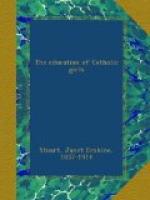In the education of girls, which is subject to so many limitations, very often short in itself, always too short for what would be desirable to attain, the best way to harmonize aesthetic teaching is not to treat it in different departments, but to centre all round the general history of art. This leaves in every stage the possibility of taking up particular branches of art study, whether historical, or technical, or practical, and these will find their right place, not dissociated from their antecedents and causes, not paramount but subordinate, and thus rightly proportioned and true in their relation to the whole progress of mankind in striving after beauty and the expression of it.
The history of art in connexion with the general history of the human race is a complement to it, ministering to the understanding of what is most intimate, stamping the expression of the dominant emotion on the countenance of every succeeding age. This is what its art has left to us, a more confidential record than its annals and chronicles, and more accessible to the young, who can often understand feelings before they can take account of facts in their historical importance. In any case the facts are clothed in living forms there where belief and aspiration and feeling have expressed themselves in works of art. If we value for children the whole impression of the centuries, especially in European history, more than the mere record of changes, the history of art will allow them to apprehend it almost as the biographies of great persons who have set their signature upon the age in which they lived.
As each of the fine arts has its own history which moves along divergent or parallel lines in different countries and periods, and as each development or check is bound up with the history of the country or period and bears its impress, the interpretation of one is assisted and enriched by the other, and both are linked together to illuminate the truth. It is only necessary to consider the position of Christian art in the thirteenth and fourteenth centuries, and the changes wrought by the Renaissance, to estimate the value of some knowledge of it in giving to children a right understanding of those times and of what they have left to the world. Again, the inferences to be drawn from the varied developments of Gothic architecture in France, Spain, and England are roads indicated to what is possible to explore in later studies,




